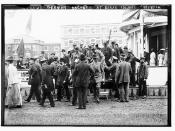The Deregulation of the German postal market and the implications for the German Bundespost
Introduction
In order to keep with market viability, public entities were forced to increase effectiveness and efficiency and thus optimize their demand for market mechanisms within the public sector. This resulted in a concept referred to as "New Public Management" which followed times of bureaucracy and unilateral public systems. As most of the greater economic companies were public or in transition to public and stock bearing, the forbearers of these stock markets have begun to expect the workings of a public company with shareholders interests being met in a public or private company.
Formerly, the government had an interest in non-privatised facets of business in that regulated articles of supply and demand were the former economy. A market mechanism such as New Public Management, even with its criticisms, is much more fitting of the current economy in which most publicly traded entities are dependant on investment.
Critics of this decision may advocate that the privatised version had more stability, however the advocates of the New Public Management approach realize that this ideology accesses a freedom, flexibility and reactivity that any old system is not capable of. Critics of the New Public Management system advocated that a closed and non-liberalized system was inefficient and unable to react to a fast and ever-changing environment. The realization of such processes has been seen as the combination of several market theories and can be regarded as a type of "hybrid solution". In recent economic history, the most consequent of such privatisations can be exemplified with the case of the Deutsche Bundespost in which a large bureaucratic and government dominated organization with a larger hierarchical structure was made public. The company employing more than 500 000 people enjoyed the benefits of having exclusive licenses in the German post and telecommunication sector. This led to a pure monopoly and its implications. Yet, during 1989 market liberalization demanded that this government institution be privatised and the government of Germany took steps to begin the process of privatisation, which is the issue within the discussion of this paper. The first part will deal with the history of the German postal system and the Deutsche Post and the privatisation and liberalization process including the postgesetz. The second part will deal with the market effects considering market movements, hierarchy and strategy. The third part will give an overview how the Deutsche Post AG strengthened their position. The fourth part will assess the privatization process in terms of what changed in the management and how the company did in numbers. Finally, the findings will be concluded and the upcoming actual challenges will be addressed.
History
In 1505 the Philipp der Schöne and Franz von Taxis founded the first cross-border European postal system (courier network) that covered most parts of Europe. After several years as a dynastical privilege, the post system opened in 1540 for the public and the building of many post office really had a significant impact on the whole development of the economy. Further developments were initiated in 1701 by Friedrich III von Brandenburg, by establishing new regulations for the postal system and a controlled mail service between the German cities. About one century later, Otto von Bismarck the "iron chancellor" of the German Empire, combined the responsibility of telegraphing and of the postal services into the German Reichspost. In 1875, Heinrich von Stephan, during that time the general postmaster, arranged an international mail delivery agreement with more than twenty countries and set the foundations to a modern postal system. Technical innovations like Zeppelins, emerging markets and fast growing infrastructure made the postal network more and more efficient.
Shortly after World War II in 1950 the German Federal Postal Service (Deutsche
Bundespost) was founded under the Allied forces instructions. In order to ensure that the Deutsche Bundespost serve postal and telecommunication services to all levels the respective authorities were assigned by the government. Therefore, this authority decided over political and managerial issues introducing the post to the public service sector. During the upcoming years, due to an increased demand in communication and the growing economic, the Deutsche Bundespost had developed into the largest company in Germany led by government institutions. In that time, the Deutsche Bundespost encompassed more than 500,000 employees and three service sectors, namely post, telecommunication and banking. As a result the Deutsche Bundespost grew into a bureaucratic elephant with a steep hierarchy structure with a long chain of command and many organizational levels.
As a consequence of being highly bureaucratic, being strongly restricted by budgets and at the same time being active in the public service sector, the inefficiency grew and according to v. Mierlo this could be interpreted as a double feedback loop (Mierlo, 2002).
In addition to the inefficiency the Deutsche Bundespost also suffers from a high degree of inflexibility, they did not focus on the quality of services and customer preferences, which was caused by its monopolistic position. This position was reached by the attempt of the German government to reach economies of scale to overcome the problem that the mail service market had very high fixed cost and comparable very low variable costs. According to Walsh (1995) economies of scale end up in monopolies where prices can be set above marginal costs and thus increase profits by reducing the total welfare. The German government favoured the monopolistic position because they didn't want that the customers have to pay the extra costs directly and therefore preferred the subsidization and the reduction of social welfare that goes along with it. Another important reason for the government was that they can directly regulate and control the mail market. These major problems, the ineffectiveness and the ineffiency, couldn't be solved by the Deutsche Bundespost and therefore led the German government to the resolution to liberalize the German mail sector. By the means of two post reforms and the subdivision into three own organizations (Mail, Telecommunication, and Finance) the government hoped that the bureaucratic elephant could cope with challenges of modern economy. As shown later, the replacement of direct control of the German government by introducing new regulations is an example of New Public Management.
The Privatization and the Regulations
Post Reform I
In 1989 the privatisation of the Deutsche Bundespost started with the first Post reform. In order to increase the quality of services, customer focus and to improve the efficiency the Deutsche Bundespost was subdivided into smaller entities. As seen in Figure 1 the Deutsche Bundespost was divided into the Deutsche Bundespost Postdienst (yellow post), which was responsible for the mail delivery, the Deutsche Bundespost Telekom (grey post) handling the telephony, and the Deutsche Bundesbank Postbank (blue post), which became responsible for the services banking activities (Deutsche Post, 2008).
Figure 1
The German government appointed a board of directors, a supervisory board, and management for the individual companies. But the General Postmaster and the Federal Ministry for Posts and Telecommunications had still the political power to steer the companies. This power enabled the ministry to ensure, by enacting laws that blanket coverage was assured. As a consequence of this, the monopolistic structure did not significantly change, since the entities could not freely act and follow its strategies, sign off alliances or compete with other organizations as it would be the case in a competitive environment (Deutsche Post, 2008). This was a major setback for the liberalization process. In some cases limited the government the monopolistic position by allowing other companies to compete in some areas.
Post Reform II
Five years later in 1994 the second reform "Post Reform II" was introduced and turned the three entities into private corporations. The Deutsche Bundespost Postdienst became the Deutsche Post AG, the Deutsche Bundespost Telekom turned into Deutsche Telekom AG and the Deutsche Bundespost Postbank was from that time on the Postbank AG (See Figure 2).
Figure 2
To make sure that each entity will develop further into a private company the German government turned them into stock companies. But to make sure that the companies follow the track of the government, the stocks were not traded on the stock market. Instead, the government held the majority of the stocks. This post reform made it possible for each of the companies to follow its strategies in the global market and to prepare the Deutsche Post AG to become competitive ... and to prepare them for going public (Deutsche Post, 2008).
Having summarized the deregulation of the Deutsche Bundespost, the following part of this paper will address the initial public offering and the liberalization of the mail market.
Going Public
In November 2000 was the Initial Public Offering of the Deutsche Post AG and since than stocks are traded on the exchange market. On that day 29% ownership of the Deutsche Post AG, worth to 6.6 billion Euros, was issued. One year later another two percent were for sale. An interesting aspect is that the company's employees hold 6 per cent of the shares, which gives good incentives for high firm performance.
Liberalization
The Organization Market Continuum made up by Walsh (2005) as seen in Figure 3 is very helpful to visualize the liberalization process of the Deutsche Bundespost.
Figure 3
Having a look on the above figure it can be seen that the Post Reform I only reorganized the Bundespost and therefore moved the Bundespost from an organization to a quasi organization. The second post reform, whichsoever transformed the three entities in private& stock companies was not sufficient for a transformation to a complete privatized company. This was because the German government kept the controlling interest of the Deutsche Bundespost. But they moved further to a quasi market organization. With the IPO, the Deutsche Post AG turned almost into a complete liberalized/market company. They were not fully liberalized because the German government awarded the Deutsche
Post AG some privileges passed by the Postgesetz (1998). The actual process then worked in step-by-step manner shown in the table below. Exclusive right Weight of the letter Up to 2003 200 gram, 2003-2005 100 gram, and 2005-2008 50 gram.
The last step of abolishing the exclusive licenses for the 50 gram letters was the most significant one, due to the fact that most of the letters are of that format. (Postmaster Magazine, 2008). Due to the fact that there was no perfect competition the Deutsche Post AG couldn't be a full market. With this loss of the Monopoly on the 1st January 2008 the Deutsche Post AG became completely liberalised and is now a full market company. Additionally it's important to see in this Organization Market Continuum how the authority changes over the different stages.
The market effects
As already discussed one of the aims of the liberalization was to bring the German post towards perfect competition away from the monopolistic structure in order to make the customer better off. In Figure 4 the situations before the privatization and afterwards are depicted.
Figure 4
First the monopoly shows a situation where, at a given quantity, the price is higher then the marginal cost, resulting in a deadweight loss. Deadweight loss can be defined by the costs to society created by inefficiency in the market (Investopedia, n.d.). Therefore, to avoid this from happening the Deutsche post had to be opened to perfect competition where the marginal costs equal the price at a given quantity. This can also be seen in Figure 4. This result is consequence of the new firms entering the market and taking away the abnormal profit levels.
Furthermore, the desired effect of efficiency and effectiveness can be achieved much more easily. As already described, the post however, still enjoyed some monopolistic privileges until the beginning of 2008. Thus it was a more subtle process bringing the Bundespost from monopoly to perfect competition.
Strengthening competition
To show this process the different steps involved will be discussed. Before 1989, when the liberalization process started and the mailing market was still in full control of the government the Bundespost could act as a pure monopoly. Even in 1997 the company still owned exclusive licenses accounting for more than 97% of the whole market. However, in 1998 the government passed the Postgesetz (post law), which decreased the exclusive licenses to 77% of the mailing sector. This was due to the introduction of the limit where every letter, weighing more than 200 gram, was allowed to be delivered by other companies than the Deutsche Post AG. From 2003 this limit was halved to 100 gram and thus the Deutsche Post AG lost another 10% of exclusive license market now only at 67%. In 2006 another step in the weights was introduced, where the Deutsche Post remained their monopoly only for letters weighing 50 grams or less, representing 59% of the market. Finally, as already mentioned the Deutsche Post AG lost all of their exclusive licenses at the beginning of 2008.
Consequences for Deutsche Post AG
Obviously the Deutsche Post cannot just decrease their prices to keep out competition as they are facing high costs, which have to be covered. On the other side when the Deutsche Post still had some monopolistic power they were not allowed to set extremely high prices. The Bundesnetzagentur was given the order to control the price levels set by the Post. Therefore, every time the Deutsche Post introduced new price levels the Bundesnetzagentur had to agree for the Post to be allowed to charge it. Regarding this aspect we can see that the government, even though the Post had exclusive licenses, did not allow the exploitation of the customers. However, generally it can be said that the Deutsche Post AG charged higher prices than it was necessary, due to inefficiencies and the comfortable position of a monopoly in a bureaucratic structure. This can be obtained from a table from the Postkundenforum where German prices for letters below 50 gram were still the highest prices compared to many developed countries. Yet, the Postgesetz altered this in a way that the price declined continually as competition increased. This is a consequence of the movement towards perfect competition, because more competitors entered the market setting lower prices and engaging in a price war. In the German market prices were decreased by 6% in the period of 2002 until 2006. This shows a clear distinction compared to other countries,where this in fact did not happen. Furthermore, the price decline was also initiated by the Bundesnetzagentur in order to prepare the Deutsche Post AG for the upcoming full liberalization of the German mailing sector. Concluding it can be noted that price for letters will further decrease since the market is now completely liberalized and more and more players enter it.
However, the recently introduced competition is not only in a price basis but also on a product basis. Following the Postgesetz the Deutsche Post AG implemented quite a considerable number of new innovations to keep ahead of its competitors. The Deutsche Post AG, for example, implemented an ERP system (Enterprise-Resource-Planning system). With the help of this IT system the Deutsche Post AG was able to reduce their delivery times by around 1 day. Furthermore, the company works with many successful companies involved in the IT sector such as Intel, International Business Machines and SAP to further exploit opportunities improving their service. Through those companies they were also able to realize a parcel tracking system called track and trace. With this system customers and the employees can always see where the parcel they are looking for is situated at the moment in real-time. Those innovations mentioned above are aimed to give the Deutsche Post AG a stronger competitive position, by firstly reducing costs and thus prices and delivering superior quality service compared to the other companies.
Structural Reasoning
Decentralized control
The Bundespost, before the two reforms was a gigantic institution with an immense labor force, which in the end was governed by the ministry of Germany. However, economies of scale are very hard to realize in this industry and the three sectors did not really provide opportunities for synergy. Thus, transaction costs were huge due the extremely long chain of commands, as shown in the figure below.
Figure 4
It shows how information is passed down and some other information is going up. In a large company like the Bundespost before the postrefom there are many layers in between the top and bottom. Thus information that is passed down might lost or false and information being requested from the bottom might be biased to make the bottom look better. Walsh argues that eventually such a situation will end up in crisis forcing the company to alter its hierarchy.
To do so the two postreforms were introduced. Their aim was it to devolve the concentrated power. Therefore, in the course of action of the first postreform the Bundespost was divided into the three already mentioned companies. Due to this, control was immensely separated and each company had much less personnel than before. Furthermore, the performance of each entity could be assessed much more easily. Subsequently, the second postreform transformed the three institutions into public corporation AGs (Aktiengesellschaft). Due to this, the companies were much more transparent and their was a much higher emphasis on performance, because the now private owners wanted earnings for their shares. The shareholders could also, through the board of directors, have influence on the management.
Monitoring
Having the state postal service in complete private hands also bears some risk. The post is a very important factor in the economy and it has to operate at all times. Thus the government has to have at least some control over the post in order ensure the functioning of the market. The government then recognized that through the post reforms, which were necessary for efficiency and effectiveness, it lost the control over the market. Thus in 1998 the German government introduced a national agency, the already mentioned Bundesnetzagentur, to keep some power over the post market. Walsh also argues that during privatization it is vital for governments not to leave the markets completely up to themselves but to monitor and regulate. In a more detailed way the Bundesnetzagentur's task is to provide, by liberalization and deregulation, for the further development of the electricity, gas, telecommunications and postal markets (Bundesnetzagentur, 2008). Looking at the institution critically it seems obvious that it also incurs costs, which could be seen as transaction costs. On the other hand it is extremely important to move towards new public management and to keep the market running steadily.
Assessment of the Privatization process Managerial Influences
When measuring the performance of the privatization of the Bundespost, one does not only has to look at the numbers but also at other attributes. Those are referred to in the studies of Gaebler and Osborne. They argue that a crisis is the actual trigger to change. In the case of the German Bundespost the slow action of the bureaucratic giant and the inefficiencies forced the Post to change, because international competition was gaining on the markets.
First, in their work of Reinventing Government they state that a healthy civic infrastructure is an important factor in the restructuring. The Deutsche Post invested heavily into the training of employees during the privatization process and new personnel replaced many civil servants. This in turn also aims at the chain of information as described before. Furthermore, the two authors lay great emphasis on leadership. During the phase of privatization, Dr. Klaus Zumwinkel acted as the CEO from 1989 until 2008. Even though the CEO is facing extreme private problems and is now on probation, because of fiscal evasion, his continuity and effort has to be acknowledged. This continuity was important for the privatization process and in our opinion private issues should be separated when assessing the leadership.
Moreover, another factor, which is mentioned in their work, is trust and belief. Gaebler and Osborne argue that during a process of change and fundamental restructuring, people have to believe in their goals and also share their beliefs. The German government also brought the necessary trust towards the Post, but did now want to give up all control and introduced the mentioned Bundesnetzagentur, which in our opinion seems to be a good balance.
Concluding it can be argued that the conditions described in Reinventing Government were generally fulfilled, which brought about the rather smooth phase of privatization in the case of the German Bundespost.
The process in numbers
When assessing the success of the privatization it is also vital to look at the numbers. First, looking at the revenue in Table 1 it immediately appears that there is a strong upwards trend. From the introduction of the Euro in 2001 the Deutsche Post AG nearly doubled their revenue. During the time between 2001 and 2006 EBIT (Earnings before interest and taxes) rose by nearly 63% and the pure profit by nearly 44%.. The drop in profit levels in 2007 is to be explained by some major write-down in the USA subsidiary, as a consequence of the financial crisis.But all in all the company produces a constant stream of profits over the years, which proves the improvement in efficiency and the overall performance.
2001 2002 2003 2004 2005 2006 2007
Revenue 33.379 39.255 40.017 43.168 44.594 60.545 63.512
EBIT 2.376 2.520 2.656 3.001 3.764 3.872 3.202
Profit 1.587 1.590 1.342 1.740 2.448 2.282 1.885
Table 1
Table 2 represents the stock market data of the Deutsche Post AG. During the last years there was first a strong upwards trend in the stock price in the dividends and the market capitalization, representing the stock price times the number of stocks outstanding. The price of the share increased by 129% during the time between 2001 and 2008. Dividends were constantly increased and the market capitalization also increased as a of the price increase. Those indicators all point to the fact that the company, during the phase of the liberalization of the mail market and its own privatization, did very well and improved in many aspects.
However, looking at the most recent numbers from the 21.12.2008 the share price fell drastically and therefore also the market cap. Yet, it has to be seen that those significant decreases did not result from the failure of the Deutsch Post, but rather from the stock market crashes all around the world ending in lower demand for the individual stocks.
2003 2004 2005 2006 2007 2008 12.2008
Share Price 10.15 16.35 16.95 20.50 22.83 23.24 11.24
Dividend per share 0.40 0.44 0.50 0.70 0.75 0.90 -
Market Capitalization 19.630 18.840 24.425 27.461 28.288 13.800
Table 2
Conclusion
Generally, it can be concluded that the privatization of the German Bundespost into the three sub-companies, especially the Deutsche Post AG, as examined in more detail, was rather successful. The bureaucratic giant was completely restructured and given to individual stockholders to increase efficiency and effectiveness and to give more incentives to perform well. Furthermore, the company worked on the customer relations and through innovations like track and trace not only reduced costs but also improved the quality of their service. From an economic perspective, the deadweight loss could be abolished, by bringing the industry from a monopolistic structure to perfect competition. Moreover, the Deutsche post AG achieved far reaching organizational capabilities by setting shared visions of the employees, cutting the chain of commands and engaging good leaders. However, it will be interesting to see how the Deutsche Post AG will act in a now completely liberalized environment. Eventually, there will be fierce competition and the Post has to keep on innovating and being dynamic.
References
Beschaffung Aktuell, (2008). Competition in the mail market. Retrieved December 22nd
from the World Wide Web:
http://www.beschaffung-aktuell.de/xml-import/bilder/ba/2005-
09/600x/thumb_ba09050006_tif.jpg
Bundesfinanzministerium, (2008). Privatisierungs- und Beteiligungspolitik, Deutsche
Post AG. Retrieved December 20th from the World Wide Web:
http://www.bundesfinanzministerium.de/nn_3384/DE/Wirtschaft__und__Verwalt
ung/Bundesliegenschaften__und__Bundesbeteiligungen/Privatisierungs__und__B
eteiligungspolitik/Deutsche__Post__AG/1821.html?__nnn=true
Bundesnetzagentur, (2008). Jahresbericht: Das vorletzte Jahr des Monopols. Retrieved
December 19th from the World Wide Web:
http://postmaster-magazin.de/archiv/07_11_07/pm_11_07_jahresbericht_bna.pdf
Bundesnetzagnetur (2008). The Agency. Retrieved December 21st from the World Wide
Web:
http://www.bundesnetzagentur.de/enid/3c51c9750323cc8762ffe7d8b1ae7333,0/F
ederal_Agency/The_Agency_xj.html
Deutsche Post World Net, (2008). Hinter den Kulissen. Retrieved December 17th from
the World Wide Web:
http://www.dpwn.de/dpwn?skin=hi&check=no&lang=de_DE&xmlFile=1002364
Deutsche Post World Net, (2008). Annual Report 2006, Retrieved December 19th from
the World Wide Web:
http://investors.dpwn.de/de/investoren/publikationen/berichte
18
/2006/geschaeftsbericht/dpwn_annual_report_2006_de.pdf
Deutsche Post World Net, (2008). Mit starken Partnern Innovationen vorantreiben.
Retrieved December 10 from the World Wide Web:
http://www.dpwn.de/dpwn?tab=1&skin=hi&check=&lang=de_DE&xmlFile=200
7683
Mierlo van, (2005). Public Entrepreneurship as Innovative Management Strategy in the
public Sector. A public Choice-Approach, Research Memorandum UM, second
revision
Osborne D., Gaebler T., (1992). Reinventing Government. How the entrepreneurial
Spirit is transforming the public sector, Page 326-327, Addison-Wesley (Reading,
Massachusetts)
Postkundenforum, (2007). Preise für Kompaktbriefe. Retrieved December 18th from the
World Wide Web: http://www.postkundenforum.de/pkf/update/pic/6_16_ID_18.jpg
Walsh J.K., (1995). Public Services and Market Mechanisms, Competition, Contracting
and the New Public Management, Palgrave Macmillan, London
Wikipedia, (2008). Bundesnetzagentur. Retrieved December 19th from the World Wide
Web:
http://de.wikipedia.org/wiki/Bundesnetzagentur
Wikipedia, (2008). Deutsche Post AG. Retrieved December 20th from the World Wide
Web:
http://en.wikipedia.org/wiki/Deutsche_Post


![[German vehicle tax registration issued to George Grantham Bain] (LOC)](https://s.writework.com/uploads/6/60390/german-vehicle-tax-registration-issued-george-grantham-bain-thumb.jpg)


